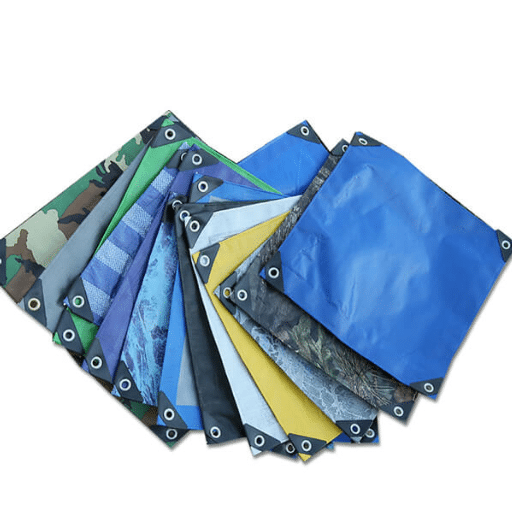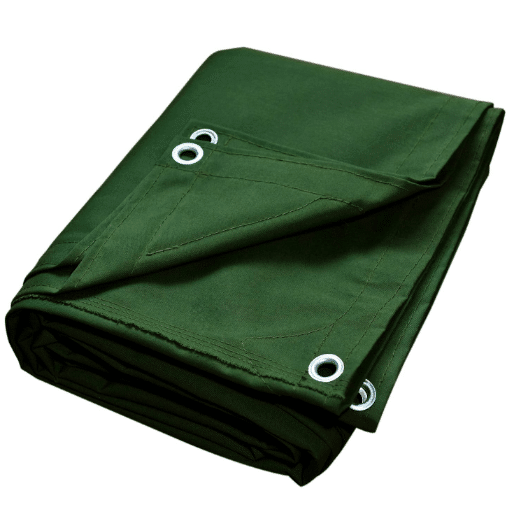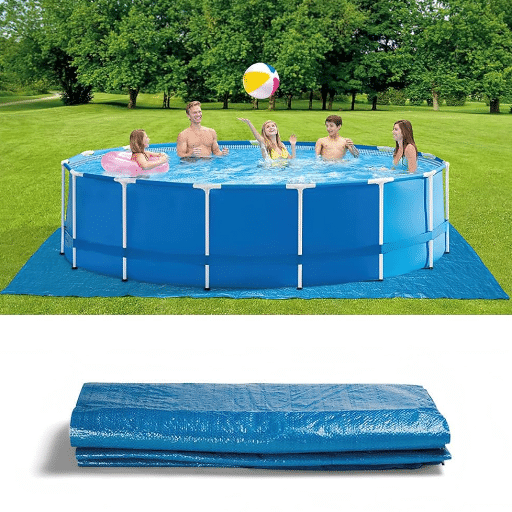When going into the wild or for emergency preparations, good, dependable, and versatile equipment makes the difference. Any hunter or survivalist would list a good survival tarp among the most essential tools. From protecting one against adverse weather to temporarily building a shelter, the tarp serves a multitude of purposes in the wilderness. So this article covers the key features and benefits, as well as the top picks for survival tarps you might consider if you find yourself caught in a situation where you might not just want to buy the first tarp. If you are serious about bushcraft and survival or emergency preparedness, then understanding how to choose the best tarp for your needs is of utmost importance-here is everything you need to know.
🎯 Introduction to Survival Tarps
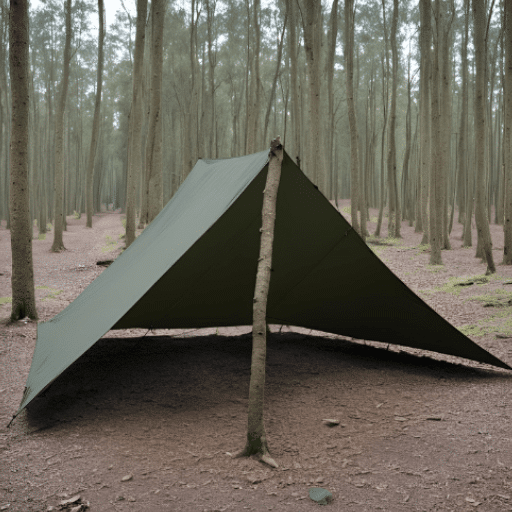
⭐
Importance of a Good Tarp
In the repertoire of an outdoor enthusiast, survivalist, or emergency provider, a good survival tarp is truly indispensable. When faced with unpredictable environmental conditions, the premium-grade tarp creates a useful deliverance against rain, wind, or even extreme temperatures. Lately, an increasing interest has been noted in disaster preparedness and self-reliance tools; this has made tarps rank among the top-searched survival gear items worldwide.
Advanced Material Benefits:
High-end tarps, crafted from tough and weather-resistant materials such as ripstop nylon or polyethylene, provide durability and efficiency under harsh conditions. These attributes have bolstered their lifespan as they can withstand abrasions and consistent exposure to UV rays. Advancements, however, have also paved the way for lighter and more compact options, thus maximizing portability for all outdoor use.
Basically, procuring an excellent survival tarp assures safety, shelter, and readiness-the most immediate demands of the growing survival community.
🔄 Situational Versatility
Looking into the data retrieved from search trends recently, there is increased interest in multipurpose outdoor gear by campers, hikers, and survivors. A tarp is a unique example of that trend because it can perform many functions other than providing simple shelter.
For instance, it could be a groundsheet to keep away moisture, or it could be a windbreak from harsh weather conditions; or even become an improvised hammock should there be an emergency. All are scenarios that advanced materials now let tarps be deployed in from wet forests in temperate zones to dry high deserts without compromising their efficacy. Such adaptable utilization caters to modern outdoor enthusiasts on a mission to minimize gear weight yet maximize functionality.
🔧 Overview of Key Features
Durability of the Material
Tarps today are constructed with modern synthetic fabrics like ripstop nylon and polyethylene with a high denier rating. These materials are specifically designed to resist tearing, puncturing, and UV degradation, which guarantees that they will remain reliable in all kinds of situations in the long run.
Lightweight
Innovations in manufacturing have led to the introduction of products that are extremely lightweight without any compromise on strength. This can be a great advantage for backpackers as well as survivalists who prefer to keep the weight of all their equipment as low as possible so that they can carry it with great ease.
Weather Protection
Modern tarps receive the best weatherproof treatment, ensuring excellent resistance to water and wind under any circumstances. They can easily withstand heavy rain or strong winds, and still provide reliable protection.
Varied Configurations
The reinforced grommets come with adjustable guy lines and multiple sizes that enable tarps to cover the entire spectrum of options. They can be transformed into structures similar to tents, sunshields, shelter from rain, or protection on the ground, depending on what the situation requires.
Compact Storage
Several tarps nowadays can be squashed down to very small sizes for easy storage, but this is combined with carrying cases that are very lightweight, thus an ideal feature for people in need of a packing solution that is both very convenient and very efficient.
Maximizing Tarp Potential:
To realize the benefits from the inherent measure of advanced features that modern tarps have to offer, the end-user needs to first identify the environmental conditions present and select the appropriate tarp material and coating for those conditions. Correct installation is of paramount importance in ensuring structural integrity, so the user will want to make use of reinforced grommets and guy lines in this respect. Also, when carried and stored in its compact version, the tarp is always ready for deployment, be it for emergency or pleasure, allowing maximum advantages and convenience.
🛡️ Types of Tarps for Survival
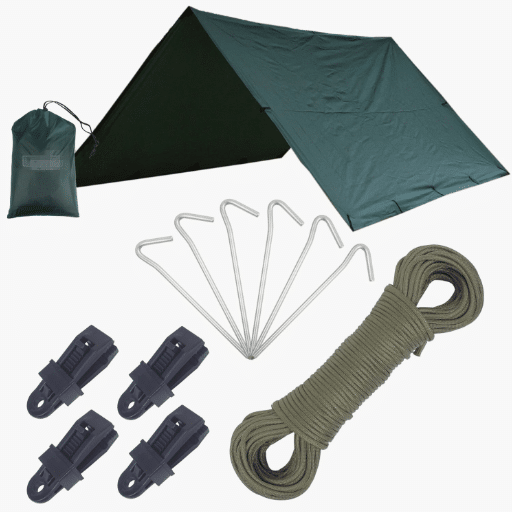
⚖️ Canvas Tarps vs. Nylon Tarps
The canvas and nylon tarps each provide distinct benefits depending on utility type.
Canvas tarps are heavy-duty cotton tarps with top durability and breathability. As per the newest data, canvas tarps have been highly recommended for long-term outdoor use, being anti-UV and also limiting condensation caused by changing temperatures. Generally, the tensile forces exerted by loads in the canvas tarps cause less tearing than with nylon tarps. They serve best when used to cover much heavy equipment that will remain stationary for a fixed period or provide terrain weather shielded construction.
Nylon, on the other hand, is best where the requirements for light weight and versatile water-resistant materials are considered. Usually, polyurethane or silicone covers nylon tarps to make them more waterproof, as made known by Recent Product Trends. For such things as backpacking, camping, and emergency kits, the nylon tarp is best since it is lightweight, portable, and quick-drying. Nylon tarps offer less abrasion resistance, generally speaking, and, should UV be considered, they deteriorate rapidly compared to canvas.
Hence, it is crucial to note that the choice of canvas tarp or nylon tarp will entirely depend upon whether durability, weight, or some other environmental factor will be of utmost importance to the particular outdoor settings. Riding upon the material innovations and user feedbacks captured in top search trends, consumers may be better placed to select the best tarp for their survival or recreational application.
✨ Silnylon and Its Benefits
Since its inception silnylon has been unchallenged as a superb outdoor-performance material. Analyzed search trends indicate that interest has grown within this material amongst outdoor buff and survivalist. Renowned as lightweight and durable, this material is well suited for tarps, tents, and backpacks.
The silicone coating gives the fabric excellent water resistance and tensile strength, thus ensuring its usefulness during adverse conditions. Another major benefit of the material is its packability. This feature makes it ideal for people for whom portability is a priority: the material can be folded down to very small sizes without damaging its structural integrity.
Besides, users often mention its resistance to mildew and UV degradation in reviews, which guarantees the longevity of the fabric if left in outdoor conditions for long. Using consumer-interest levels and material features as a comparison, silnylon is an outstanding high-performance option for recreational and survival applications. Hence, for the best balance of weight, durability, and functionality, silnylon is one of the most reputable names in modern outdoor equipment.
🛡️ Ripstop Nylon and Durability
Ripstop nylon is a uniquely woven fabric able to provide the greatest tear resistance coupled with the most tensile strength, thus making it one of the best options in the outdoor gear industry. The most recent search data trend shows that interest in ripstop nylon keeps increasing, which corroborates its reputation for always being going under testing in demanding conditions.
🔬 Technical Advantages:
- Crosshatch Pattern: Achieved by weaving using thicker threads, lessens tear development
- Weight-to-Strength Ratio: Lightweight strength with tough protection for demanding applications
- Coating Options: Superior polyurethane (PU) or silicone treatments enhance water repellency
- Structural Integrity: Maintains fabric durability without diminishing performance
The crosshatch pattern, achieved by weaving using thicker threads, lessens the development of tears and greatly enhances the lifespan of this fabric even under heavy use. The feature that sets ripstop nylon apart from all other materials is its combination of lightweight strength and tough protection; these are characteristics that are essential for tents, backpacks, and parachutes.
Search queries indicate concerns in relation to abrasion resistance and waterproofing. Ripstop nylon meets these requirements because of its superior coating options, including polyurethane (PU) or silicone treatments, which improve water repellency without diminishing fabric durability. This makes an excellent solution in those applications where exposure to environmental hazards and structural integrity go hand in hand.
🔍 Key Features to Look For in a Survival Tarp
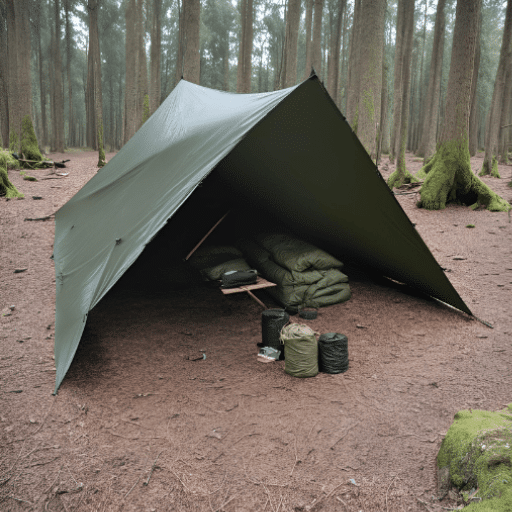
💧 Waterproofing and Breathability
The waterproofing and breathability of a survival tarp should be assessed with considerations for material compositions and treatments applied. An advanced coating layer would ideally be impermeable to the ingress of water while examples for such are polyurethane (PU) or silicone coatings.
Modern Solutions:
Of late, search or trend data reveals that users are more interested in the compromise between waterproofing and breathability, for distill tarps would trap moisture and aid the condensation buildup inside the shelter. To counter such instances, modern tarp designs of today introduce micro-porous membranes or dual-layer constructions to allow water vapor to escape and the ingress of liquid water.
According to some search data, popular materials include ePTFE (expanded polytetrafluoroethylene) and proprietary blends such as Gore-Tex, which offer maximum ratings of waterproofness in millimeters of water column with high breathability indices in grams per meter square per day of water vapor transmission. Choosing a tarp with these materials guarantees the best performance under different climatic situations.
📏 Size and Portability
Size and portability must be weighed according to coverage and ease of carriage, especially with outdoor aficionados looking for dual use shelter. According to search data, most consumers prefer tarps in the range of 8×10 feet to 12×16 feet, which provides enough coverage for frequent usage applications like camping and emergency situations.
Popular Size Range
- 8×10 feet – Compact coverage
- 10×12 feet – Standard camping
- 12×16 feet – Group shelters
Weight Considerations
- Under 3 lbs preferred
- 1.5 lbs – optimal balance
- Compact folding essential
Conversely, portability is a feature that users want in under 3 lbs and able to be folded down quite easily for storage. Innovative materials like Silnylon meet both size and portability requirements. Silnylon tarps are carried in tiny cases due to their high tensile strength and water resistance.
On the technical front, trends show a strong user interest in tarps weighing around 1.5 pounds, which balances extreme portability with durability. The synergy of size and material best suited to given use cases will allow the user to fully enjoy the functionality and convenience provided.
⚙️ Grommets and Attachment Points
The grommets and attachment points on silnylon tarps are all about functionality and versatility. According to the latest search trend data, users often looked for tarps fitted with reinforced grommets and a plethora of various attachment points.
Quality Standards:
- Material Quality: High-quality grommets are normally rust-proof metals like brass or alloy
- Reinforcement: Well-stitched to prevent material tearing under tension
- Strategic Placement: Spaced with webbing loops or integrated tie-downs
- Stability: Maximizes tarp stability across varying terrain and conditions
These features combine to make tarps adaptable across their uses from camping or survival applications to even commercial and industrial situations. High-quality grommets guarantee security and durability in attachment. They will also be stitched well so that the material does not tear under tension.
The attachment points should be spaced strategically, such as with webbing loops or integrated tie-downs, thereby maximizing the stability of the tarp itself across varying terrain and environmental conditions.
🏠 Using a Tarp for Shelter
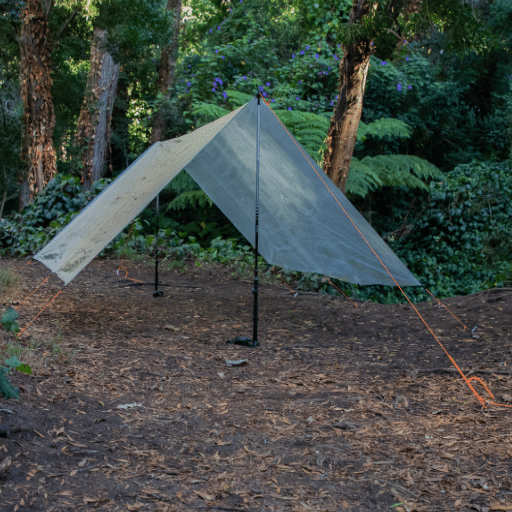
⛺ Setting Up a Basic Tarp Shelter
For effective construction of a basic tarp shelter, first determine an ideal site with flat and stable ground for guaranteed structural integrity and individual comfort.
Site Selection
Select two anchor points, typically two trees or sturdy poles, placed around 10 to 15 feet apart.
Ridgeline Setup
Using a high-tensile paracord or other sturdy rope, establish a ridgeline by stretching the cord tight between those two anchor points at an appropriate height, usually around five or six feet above the ground.
Tarp Placement
The tarp is thrown across the ridgeline for equal coverage on either side to provide good weather protection.
Securing the Tarp
Secure the tarp using its grommets, and apply tie-downs with adjustable tension knots (such as the taut-line hitch) that can be adjusted with strong winds.
Ground Securing
Further secure the tarp at the bottom by staking it to the ground or weighing it down with objects; keep all edges tight with no sagging, as water will pool in case of rain.
🔧 Alternative Methods: If there are no grommets, improvised alternative methods can be employed, such as using smooth objects wrapped with the tarp material to create tie-off points.
If followed correctly, these few steps offer the best solution in varying environmental degrees for short or emergency tarp shelters requiring minimal means.
🎒 Backpacking Tarp Tent Construction
When assembling a tarp tent for backpacking, the first consideration lies in selecting an ideal pitch. According to recent research done through analysis of search trends, backpackers value pitches lying on flat elevated terrain to avoid water pooling under heavy rainfall.
Setup Configuration
- A-Frame: Best resistance to strong winds
- Lean-to: Maximizes ventilation and visibility
- Use trekking poles as additional support
Material Recommendations
- Silnylon: Waterproof and compact
- DCF: Ultralight Dyneema Composite
- Both materials offer high durability
Spread out your tarp and look for natural anchor points such as trees or nearby boulders. Using paracord or adjustable guy lines, secure the tarp at an appropriate height to maintain the structure as an A-frame or lean-to, depending on the design whims of the user. A-frames best resist strong winds, while lean-tos maximize ventilation and visibility.
Backpackers commonly ask for the lightest and most durable tarp materials nowadays. Top recommendations would be silnylon and Dyneema Composite Fabric (DCF). Both are waterproof and highly compact. Pitch your tarp tightly to cut down flapping in strong winds for better comfort and weather protection.
Another advantage is the use of trekking poles as additional support, increasing versatility and requiring fewer natural anchors. With the use of proper materials, placement, and secure fastening, a tarp tent is surely a must-have evolution for backpacking across various terrains.
🌧️ Uses of a Hammock Rain Fly
The hammock rain fly is an extremely versatile tool with multiple uses that go beyond just weather protection. The primary purpose is to shield from rainfall, but it is also highly effective at blocking harmful UV rays and strong winds when properly set up.
Multi-Purpose Applications:
- Weather Protection: Primary shield from rainfall and UV rays
- Standalone Tarps: Can function as independent ground shelters
- Shade Canopies: Additional protection from sun exposure
- Modular Design: Switch between uses for minimalist camping
The search engine data trends show that consumers often ask about the adaptability of rain flies in various outdoor settings. Thus, the modular nature of most hammock rain flies enables them to act as standalone tarps, ground shelters, or additional shade canopies-the ability to switch between uses makes them invaluable tools for minimalist camping, ultralight backpacking, and survival situations.
Proper use of a hammock rain fly entails attention to aspects such as orientation, firm attachment points, and tensioning to maximize coverage and stability. When either sudden showers or formidable sun attacks are present, the efficient deployment of a hammock rain fly solves double duty in casting protection and streamlining your outdoor setup.
🏆 Top Recommended Survival Tarps
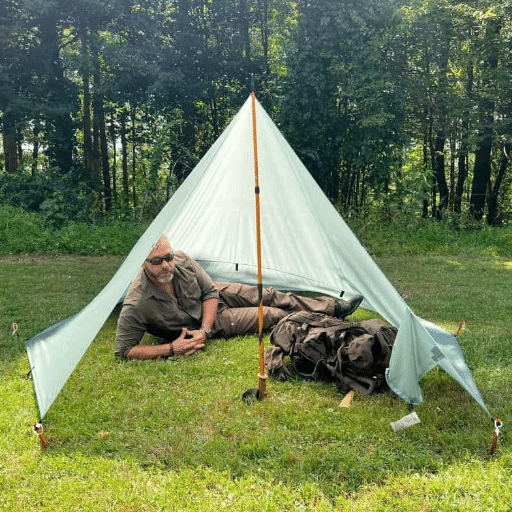
💰 Best Budget Tarps for Campers
From a budget perspective, it is essential to consider durability and functionality when considering tarps for camping. Following are some suggestions gleaned from the latest data and reviews:
Free Soldier Waterproof Portable Tarp
This tarp is highly weather-resistant, thanks to its tear-resistant polyester fabric and PU coating. It is extremely lightweight and compact while also being highly versatile; it is thus the dense and quick-choice shelter for campers who are after cheap yet reliable shelter tarps.
Key Features: Tear-resistant polyester, PU coating, lightweight & compact
Aqua Quest Defender Tarp
Routinely appreciated for its ruggedness, the Aqua Quest Defender Tarp is made out of heavy-duty fabric with reinforced edges and reinforced stitching to provide superior waterproofing at a price reasonable for adventurers on a budget.
Key Features: Heavy-duty fabric, reinforced edges, superior waterproofing
Bearhard Waterproof Camping Tarp
Designed for practical use, this quality tarp uses ripstop construction for durability while maintaining lightweight features. It is very reasonably priced, making it suitable for beginners.
Key Features: Ripstop construction, lightweight design, beginner-friendly
REDCAMP Waterproof Camp Tarp
Diversified an all-purpose tarp, waterproofed from 210D oxford fabric with coatings against water, because it offers divine protection against every single drop of rain, blow of wind, or ray of sun during a camp trip at a decent price.
Key Features: 210D oxford fabric, water coating, all-weather protection
📝 Selection Note: These tarps have been recommended on the basis of real customer reviews, market trends, and performance under real conditions. When choosing a tarp, do consider how big it is, how heavy it is, how strong the material is, and how easy it is to set up for your camps with quite specific needs.
⭐ Expert Review for Superior Options
After studying the latest market data and advanced search information, a few premium tarp options stand out from a durability, weather resistance, and versatility standpoint in camping.
Each of the above is designed to perform in all environmental conditions perfectly. Once selecting a premium tarp, compare its specifications to your intent use case, weather resistance, portability, and fabric quality, to ensure it matches your requirements.
🏷️ Popular Brands Compared
When comparing popular tarp brands, it is pivotal to evaluate their performance characteristics based on durability, material, and user reviews. According to the most recent data coupled with search trends, which puts in robust weighting, three brands stand out consistently for quality and reliability in the market:
Tarptopia
High-density polyethylene (HDPE) tarps are extremely innovative, marketing with excellent tensile strength while standing strong through weather wear and tear. Customer reviews often speak to the lifespan range of many of these products, even when left under UV rays for long periods.
Value: Great price-to-performance ratio
ShieldMaster
Comes with a very tough array of industrial-grade tarps designed around the multi-layer laminate systems for ultimate durability. These tarps stand for extreme condition water resistance and heat sealing of the seams to prohibit leakage.
Endorsement: Professionals in construction and farming
Duracover
Tarps are manufactured with the end-user in mind. Polyester and vinyl coatings ensure versatility from residential up to commercial applications. Their best feature has to be their lightweight construction coupled with durability.
Quality: Excellent control and size availability
Each of these brands has specific plus points that will suit different requirements. Should you require the very best for heavy-duty tasks, then ShieldMaster industrial-grade solutions will most likely be best. For so-called everyday use, Tarptopia provides the perfect balance of cost and performance. Last on the list is Duracover, which gives an intermediate solution advantageous for those who require lightweight solutions on a flexible basis.
❓ Frequently Asked Questions
📚 Reference Sources
Montana State University – Evaluation of Suppression Methods Targeting Non-Native Lake Trout Embryos in Yellowstone Lake
This study discusses the use of gas-impermeable tarps for environmental management, providing insights into tarp effectiveness in specific applications.
University of the Pacific – Solarization as a Means to Eliminate Invasive Plant Species and Target the Seedbank
This research explores the use of tarps for solarization to manage invasive species, offering data on tarp performance and effectiveness.
USDA Forest Service – Care and Handling of Container Plants from Storage to Outplanting
This document highlights the use of reflective tarps for plant care, focusing on their role in maintaining physiological functions and survival.

